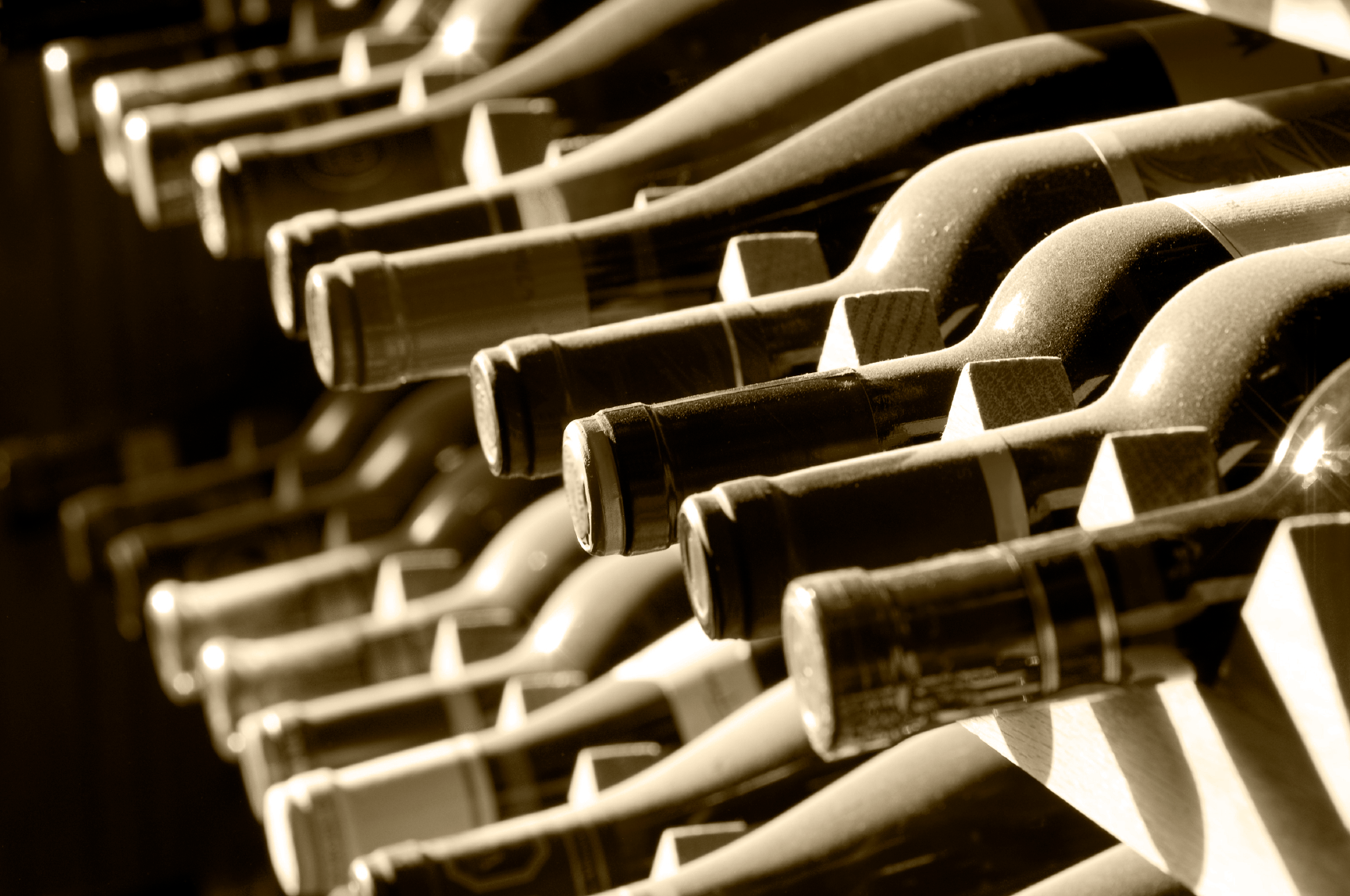Now, we’ve got the (potentially dry) production process out of the way we can look at the main styles of true, definitely dry Sherry sometimes referred to as Vinos Generosos. It’s worth noting that most wines labelled Amontillado and Oloroso are sweetened and although some of these are of excellent quality (e.g. William & Humbert’s “As You Like It”), they’re often not worth bothering with. If you want to avoid these, look out for labelling terms such as “medium” and “cream”.
NB: all these Sherries should be served in a proper white wine glass to maximise their aromatic qualities and not in the Lady Dowager’s cut glass doll’s house stemware.
Fino – This is bone dry, pale and light bodied, typically with aromas of almonds, bread dough and wild herbs. It is a biologically aged wine and takes much of its distinctive flavour and nature from being nurtured under a layer of yeast know as flor for at least two years but in some cases as many as ten or eleven if the scales are run often and the conditions in the bodega allow. Once the base wine is made it is fortified to between 14.5% abv to 15.5% abv and the barrels are filled but never completely. At this alcohol level and with plenty of oxygen available to it through the head space in the barrel, the flor can thrive and impart its unique flavours into the wine at the same time as protecting it from oxygen and therefore preserving its freshness.
The conditions in the bodega are crucial here – the flor likes things relatively cool and humid which promotes its growth, enhancing the classic characteristics of the wine. In Sanlúcar de Barrameda, a coastal town where maritime influence makes things cooler and wetter than in Jerez, wines that would otherwise be labelled as Fino bear the protected name Manzanilla – a tribute to their unique delicacy and freshness
An En Rama (literally “on the vine”, figuratively “raw”) Fino undergoes a far less intensive clarification than a typical Fino. The result is a more complex, intense experience as along with sediment, flavour is also stripped away during the clarification process. The downside is the wine is less stable because microbes that would otherwise be stripped away during clarification remain. They are therefore best drunk as soon as possible after release. A seasonal wine.
Serving Temperature: Chilled (6°C – 8°C). Not at room temperature from a bottle that’s been open since Easter. Freshness is vital.
Food Pairing Suggestions: All kinds of tapas but especially seafood. Grilled prawns in garlic are good or anything salty. A bowl of salted almonds and a glass of Fino on a summer’s evening is about as good as life gets for me.
Amontillado – This starts life as Fino but becomes an Amontillado when the flor dies and the air gets to it (again the barrels are only 4/5 full). This can be achieved by fortifying the wine with grape brandy to 16% or so to kill it or waiting for it to die off naturally in time. Without the protection of the flor the wine begins to age oxidatively which results in a darker colour, more hazelnutty, dried citrus aromas and fuller body. They therefore combine the characteristics of biological and oxidative ageing and can be incredibly complex wines.
Serving Temperature: Lightly chilled (12°C – 14°C)
Food Pairing Suggestions: Roast poultry, tuna, mushroom risotto, hard cheese and anything with asparagus or artichokes.
Oloroso – Translating as “fragrant” these are made from the coarser pressings described last week. They are fortified to around 18% and put in barrel to age. This means they are entirely oxidatively aged without any influence from the flor which is killed by the concentration of alcohol. The exposure to air results in a darker, nuttier wine which through time and evaporation can become very full bodied, intense and rich with the appearance of sweetness whilst still being dry. They often have flavours more akin to walnut than hazelnut or almond and often bitter orange.
Serving Temperature: Lightly chilled (12°C – 14°C)
Food Pairing Suggestions: Meat stews, chorizo, pig and ox cheeks, game, wild mushrooms and hard cheese.
Palo Cortado – It is said only 100,000 bottles of this style are produced in a single year (compared to around 60,000,000 bottles of Sherry in total). Often marketed as a mystery of nature it is said one can’t deliberately make a Palo Cortado, rather it “occurs” by chance when a wine that is pre-selected to become a Fino or Amontillado, for whatever reason, doesn’t develop a flor and the wine therefore ages oxidatively from the start like an Oloroso. I’m slightly sceptical of this as commercial reality demands a degree of certainty and the knowledge and experience of many modern winemakers is surely sufficient to create a Palo Cortado by design. The winemaker will make a note of the barrels that develop this way and mark them out for life as a Palo Cortado.
The end result is a wine with the mouthfeel of an Oloroso and the elegant aromatic qualities of an Amontillado. They are often amongst the highest quality Sherries and are highly sort after.
Serving Temperature: Lightly chilled (12°C – 14°C)
Food Pairing Suggestions: Nuts, hard cheeses, cured meat, roasted red meat, ox cheek dishes and game pie.
A Note on VOS/VORS
You may have noticed these labelling terms adorning the bottles on the shelves of your local wine merchant. They were introduced by the region’s Consejo Regulador in 2000 to guarantee a certain average age and quality as previous age statements such a Muy Viejo weren’t governed by law and were potentially misleading or inconsistent between different producers. VOS (Vinum Optimum Signatum) indicates an average age of 20 years and VORS (Vinum Optimum Rare Signatum) 30 years. Less than 1% of all Sherry produced qualifies for the right to bear these terms and they are reliably wines of the very highest quality.
Some Sherries to Try
If you’re new to Sherry (and if you’ve managed to get this far, well done), Gonzalez Byass’ Tio Pepe is a great place to start to experience an affordable, well-made Fino. It’s, fresh, vital and, as an added bonus, available nationwide in pretty much every supermarket for around £10. You’ll often see a half opened bottle on the shelf of your local boozer alongside similarly ruined bottles of Vermouth and Campari. Avoid these like the plague/Prosecco. They need to be freshly opened and chilled.
Gonzalez Byass is one the largest and certainly amongst the best producers in the region. Their “Palmas” range is an excellent insight into high quality, traditional Fino and drinking through it, from the youngest Una Palma to the Cuatro Palmas Amontillado (by this point it has passed from a Fino into its Amontillado state) is a great way to see the effect of the Solera ageing process in action with the wines gaining weight and complexity as time passes.

All are available at Wine-Boar.com
Gonzalez Byass also produce and excellent 12 year old Palo Cortado (Leonor) a great introductory Amontillado (Viña AB) and an 8 year old Oloroso (Alfonso). All are priced at less than £15 a bottle, are widely available and offer fantastic drinking.
If you’re feeling fruity and want to experience something really special, the wines of Bodegas Tradición and Equipo Navazos will never disappoint – if you can find them. These are invariably low volume wines and highly sort after so expect to pay a premium. As with all Sherries however they still offer tremendous value for the quality on offer.








